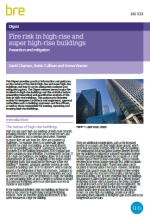Fire risk in high-rise and super high-rise buildings DG 533
BRE (Building Research Establishment) is an independent, research-based consultancy, testing and training organisation, operating in the built environment and associated industries.
Ensuring high-rise buildings are safe presents a number of challenges. For example, there is no standard definition of what a high-rise building is. Traditionally, in the context of fire, high-rise buildings have been considered to be buildings high enough that a fire cannot be fought using standard firefighting methods. As a result, there are significant differences to the fire safety measures required in high-rise buildings. These related to; the number of occupants high above the ground, the possible adoption of a phased evacuation strategy or a ‘defend in place’ strategy, the length of time needed to evacuate and so on.
Fire risk in high-rise and super high-rise buildings: Prevention and mitigation (DG 533) was written by David Charters, Roisin Cullinan and Emma Warren, and published by BRE on 21 August 2014.
The 12-page digest provides guidance about the nature of fire risk in high-rise and super high-rise buildings and how it can assessed and mitigated. It reviews a number of fires in high-rise buildings and presents theoretical and quantitative analysis of fire risks.
The digest is intended for designers (such as architects and engineers), approval authorities (such as building control bodies and fire officers), as well as the owners, operators and insurers of high-rise buildings.
The contents of the digest include:
- Introduction.
- The nature of high-rise buildings.
- Existing guidance for fire safety in high-rise buildings.
- Fire events in high-rise buildings.
- Examples of high-rise building fire events.
- One Meridian Plaza, Philadelphia, 1991.
- World Trade Center, New York, 2001.
- Cook County Administration Building, Chicago, 2003.
- Windsor Tower Fire, Madrid, 2005.
- Analysis of fire risks in high-rise buildings.
- Risk as a function of the height of a building.
- Analysis of fire statistics.
- Computer model for fire risk in high-rise buildings.
- Results of analysis.
- Findings and conclusions.
- References.
[edit] Related articles on Designing Buildings
- Addressing building failures: Grenfell Tower and Edinburgh schools.
- Automatic fire sprinkler systems: A good practice guide.
- BRE articles on Designing Buildings Wiki.
- BRE Buzz articles on Designing Buildings Wiki.
- BRE Buzz.
- Building Research Establishment.
- Buildings of a great height IGH.
- Buildings of a very great height ITGH.
- EWS1 forms not required for buildings without cladding.
- Fire in buildings.
- Fire protection engineering.
- Fire safety design.
- Grenfell Tower fire.
- High-rise building.
- Managing fire risk in commercial buildings: A guide for facilities managers.
- Megastructure.
- Megatall.
- Scottish Advice Note addresses fire risk in multi-storey residential buildings.
- Specify with caution to new BS 8579:2020.
- Sprinkler.
- Super-slender.
- Supertall.
- Tallest buildings in the world.
Featured articles and news
Latest Build UK Building Safety Regime explainer published
Key elements in one short, now updated document.
UKGBC launch the UK Climate Resilience Roadmap
First guidance of its kind on direct climate impacts for the built environment and how it can adapt.
CLC Health, Safety and Wellbeing Strategy 2025
Launched by the Minister for Industry to look at fatalities on site, improving mental health and other issues.
One of the most impressive Victorian architects. Book review.
Common Assessment Standard now with building safety
New CAS update now includes mandatory building safety questions.
RTPI leader to become new CIOB Chief Executive Officer
Dr Victoria Hills MRTPI, FICE to take over after Caroline Gumble’s departure.
Social and affordable housing, a long term plan for delivery
The “Delivering a Decade of Renewal for Social and Affordable Housing” strategy sets out future path.
A change to adoptive architecture
Effects of global weather warming on architectural detailing, material choice and human interaction.
The proposed publicly owned and backed subsidiary of Homes England, to facilitate new homes.
How big is the problem and what can we do to mitigate the effects?
Overheating guidance and tools for building designers
A number of cool guides to help with the heat.
The UK's Modern Industrial Strategy: A 10 year plan
Previous consultation criticism, current key elements and general support with some persisting reservations.
Building Safety Regulator reforms
New roles, new staff and a new fast track service pave the way for a single construction regulator.
Architectural Technologist CPDs and Communications
CIAT CPD… and how you can do it!
Cooling centres and cool spaces
Managing extreme heat in cities by directing the public to places for heat stress relief and water sources.
Winter gardens: A brief history and warm variations
Extending the season with glass in different forms and terms.
Restoring Great Yarmouth's Winter Gardens
Transforming one of the least sustainable constructions imaginable.
























